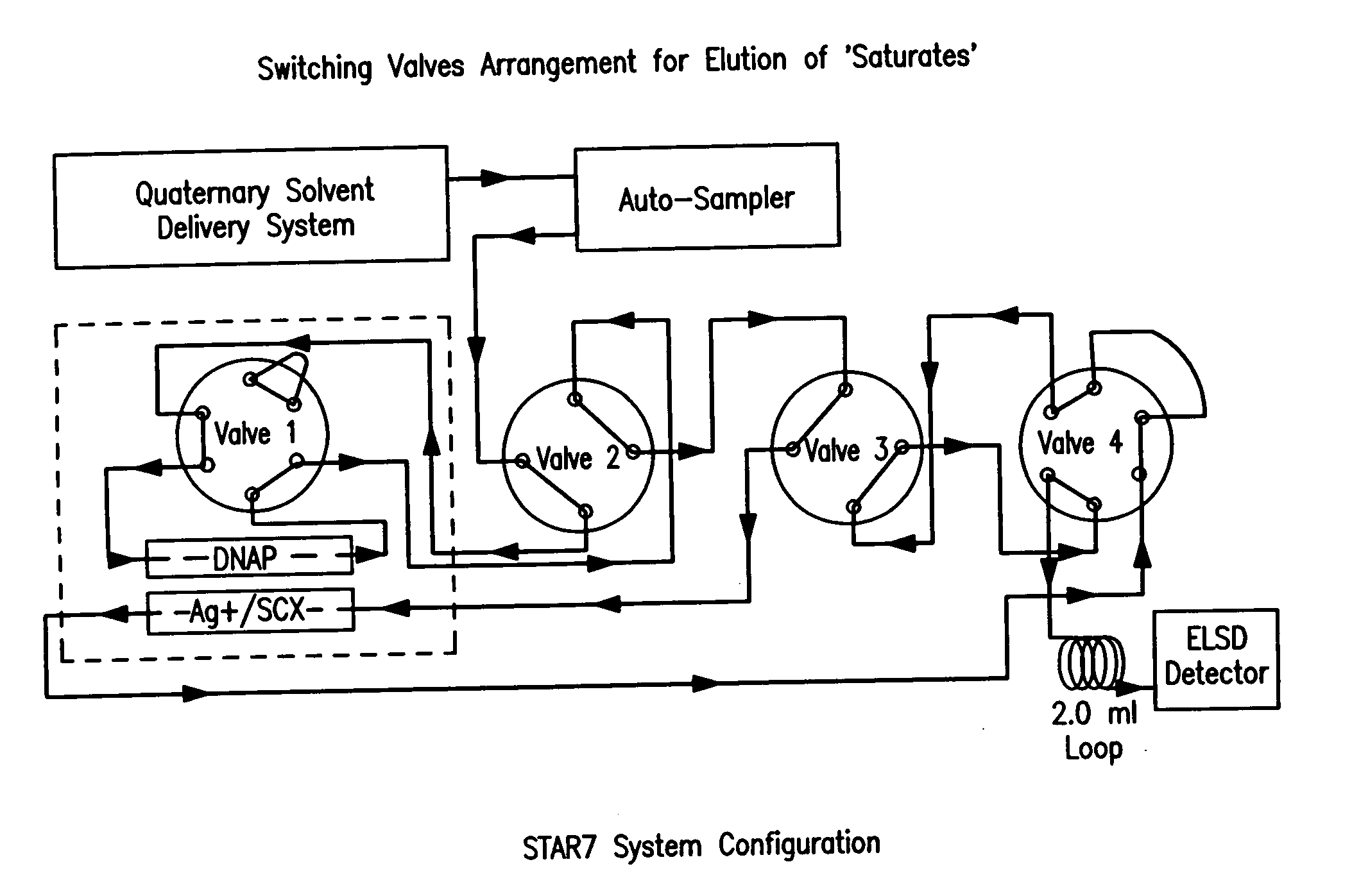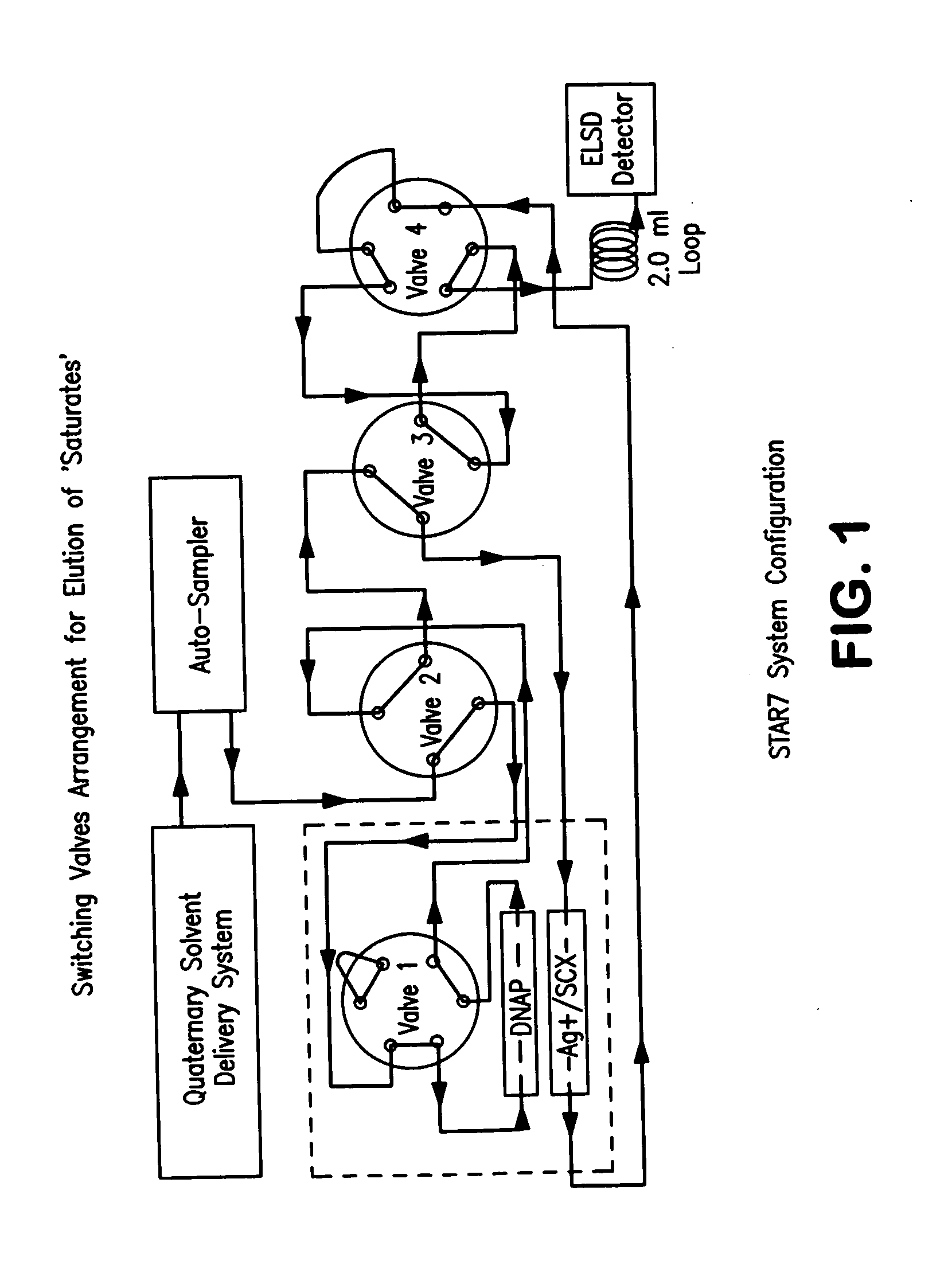Multi-dimentional high performance liquid chromatographic separation technique (STAR7) for quantitative determinations of 7 fractions in heavy petroleum streams boiling above 550 degrees F
- Summary
- Abstract
- Description
- Claims
- Application Information
AI Technical Summary
Benefits of technology
Problems solved by technology
Method used
Image
Examples
example 1
[0058]A six peak solution was prepared by dissolving approximately same amount of each of the model compounds representing the 6 classes of compounds, namely n-eicosane (saturate component), n-nonadecyl-benzene (ARC-1 component), 2,6-di-iso-propyl-naphthalene (ARC-2 component), phenanthrene (ARC-3 component), pyrene (ARC-4 component), and n-dodecyl sulfide in hexane solvent, and then analyzed using the final STAR-7 method. As shown in FIG. 4 that all the components are baseline separated. However, the peaks' shapes and hence the peak areas vary significantly from component to component. Although the peak shapes were improved by using a 2-mL stainless loop ( 1 / 16″), placed between the last switching valve and the mass detector, the peak areas remained different. The different peaks for same amounts of different components strongly suggested that each of the component peaks must be calibrated independently in order to obtain accurate quantitative analysis data.
example 2
[0059]A solution (100 mg in10 ml of cyclohexane) of a petroleum distillate, which we had separated several times by preparative liquid chromatography, was also chromatographed several times using STAR7. A typical chromatogram is shown in FIG. 5.
Calibration of Mass Detector (ELSD)
[0060]Although the ELSD calibrations could be made using model compounds, we found out that the calibration curves change slightly, depending upon the type of compound chosen, for example n-eicosane (paraffinic saturate) versus cholestane (naphthenic saturate). Also, since the goal was to match the STAR7 quantitation with that of preparative HPLC separations, we decided to use a petroleum distillate (a preparative HPLC quality control sample) sample as a single calibration sample for calibration of all the START peaks over a wide range of concentrations. Because the ELSD is a non-linear detector, we had to find the best fit for the detector response against the sample amount in order to convert the peak area...
example 3
[0068]For comparison purposes, a solution (Approx. 100 mg in 10 ml of cyclohexane) of a petroleum distillate was analyzed using the two analytical (STAR7 and HPLC-2) methods. The two chromatograms shown in FIG. 9 clearly demonstrate the superiority of the STAR7 method. In STAR7 in addition to the saturates and ARC-1 baseline separation, the rest of the 5 components are also well-defined and baseline separated. Also, STAR7 provides quantition of an additional fraction, the sulfides.
TABLE 6Comparison between Analytical HPLC (STAR7) and PreparativeHPLC Separations DataSaturatesARC-1ARC-2ARC-3ARC-4SulfidesPolarsPrep-Prep-Prep-Prep-Prep-Prep-SampleHPLCSTAR 7HPLCSTAR 7Prep-HPLCSTAR 7HPLCSTAR 7HPLCSTAR 7HPLCSTAR 7HPLCSTAR 7QC-148.350.716.014.814.112.810.610.25.95.84.04.21.31.4QC-223.823.814.715.717.718.817.617.813.310.75.84.77.28.5Blend-1*5.55.032.231.628.526.921.420.911.811.70.51.80.11.0Blend-2*10.29.230.528.926.927.620.219.411.211.00.81.90.31.1Blend-3*72.773.98.47.87.47.15.65.33.13.02.12...
PUM
 Login to View More
Login to View More Abstract
Description
Claims
Application Information
 Login to View More
Login to View More - R&D
- Intellectual Property
- Life Sciences
- Materials
- Tech Scout
- Unparalleled Data Quality
- Higher Quality Content
- 60% Fewer Hallucinations
Browse by: Latest US Patents, China's latest patents, Technical Efficacy Thesaurus, Application Domain, Technology Topic, Popular Technical Reports.
© 2025 PatSnap. All rights reserved.Legal|Privacy policy|Modern Slavery Act Transparency Statement|Sitemap|About US| Contact US: help@patsnap.com



